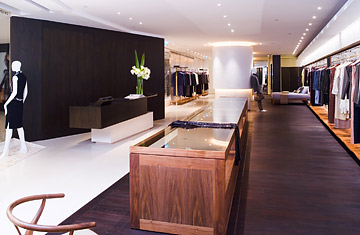
"Now things from China often connote poor quality, but it was not too long ago that it was the West looking to the East," says Kin Yeung, chairman and founder of Blanc de Chine, explaining how he came to name his Hong Kong-based clothing line after the French term for China's famous white porcelain. "Blanc de Chine reminds us that things produced in China were looked upon by Europeans for quality and tasteful design, instead of the cheapness that Chinese products nowadays are associated with. I thought it would be a good aspiration to do something of quality."
High-end fashion hasn't always been on Yeung's radar. After attending college in San Francisco, Yeung, 65, joined his family's real estate investment and development company, where he worked on projects in Asia and New York City. In the late 1980s he was providing space to a large Chinese trading company that specialized in arts and crafts. Realizing that arts and crafts "had been more craft than art, in a certain sense, repeating the things that have been handed down for hundreds of years," he proposed an idea to create a shop-in-shop for the company, called China Workshop Concept. It would sell an updated and upgraded version of tradition and focus on Yeung's interest in home furnishings. But after three years of preparation — and a decision to switch from furnishings to silk garments — the partnership disintegrated, and China Workshop Concept became the freestanding Blanc de Chine.
Since the opening of Blanc de Chine's first store in Hong Kong in 1993, the brand's unique philosophy and meticulously constructed products as well as its high prices have set it apart from other brands in China. "At the time when we started Blanc de Chine, garment design had been predominantly visually driven," Yeung says. "We decided to go beyond that and try to explore the other senses whenever applicable." That exploration involves dimensions of time, physical structure and senses. The brand's motto, "So ancient, so modern," derives from Blanc de Chine's integration of time in its designs. "We take something from the past and look to the future to come up with something for the present," Yeung explains. Dimensions of physical structure are apparent in the sometimes surprising and nonintuitive ways Blanc de Chine fashions are meant to be worn — like a large silk square with a circle cut out of the middle that, when donned just so, takes on the appearance of a vest. And dimensions of senses draw upon the Buddhist quest to understand consciousness and perception. "By recognizing the senses, we invoke multidimensional interactions between the body and clothes," Yeung says.
Not satisfied, Yeung set a goal of incorporating eight Zen-influenced elements — simplicity, serenity, purity, harmony, comfort, subtlety, sensuality and functionality — into every Blanc de Chine design. His favorite example is the Mien O, a quilted jacket. "It is comfortable and very functional," he says. "And unlike the Western jacket, it is unstructured."
But perhaps the most interesting aspect of the company's approach to design is the integration of Chinese history and culture into its fashions. Following Yeung's directive for each season, Blanc de Chine's six designers cull inspiration from a specific dynasty or minority tribal culture in China's history. An example of how this manifests itself in the clothes is the collection several seasons ago influenced by the Tang dynasty. For Blanc de Chine, the forward-thinking nature of this period translated into low-cut styles and transparent fabrics — while it maintained the brand's sense of tradition and timelessness. "In order to be socially relevant, adaptation and modifications are necessary — otherwise, [the clothes]become mere costumes," says Yeung.
As an outsider in the fashion industry, Yeung struggled initially to get Blanc de Chine's products made to his exacting specifications. In a country where mass production is the norm, he relied on well-connected friends to help him get small orders produced. Eventually he bought a factory in mainland China, where he ensures that all of Blanc de Chine's fashions, along with its accessories and home products, are made to his satisfaction. In addition to producing his own silks, Yeung scours the famous Premiére Vision fabric show for the best materials and works with Loro Piana and Swiss fabricmakers like Jakob Schlaepfer and Weisbrod. "I don't think I can be competitive coming from the cheap end," says Yeung. "If I were to do that, I may as well put my investment in real estate, which is more rewarding and less demanding. When I first started and was paying attention to the insides of garments as well as the outsides, even my son would give me dirty looks and said obviously I was not in the industry. I have no sense of cost, but I always believed that people would pay for a well-designed garment."
His faith has paid off. Hollywood celebrities Michelle Yeoh, Chris Tucker and Jackie Chan have all sported Blanc de Chine's styles. The company now employs over 400 people and operates stores in Beijing, New York City and Hong Kong. Another Beijing store is set to open this fall. And Bleu de Chine, a more affordable casual line, officially launched last month.
As China's luxury market continues to grow, there's bound to be new competition for Blanc de Chine. Still, Yeung isn't worried: "It is only natural that China is becoming a very attractive marketplace for international brands. Despite that, there is a growing national pride among China's more affluent consumers in wearing Chinese-designed clothing. And that's where the opportunity for Blanc de Chine lies."